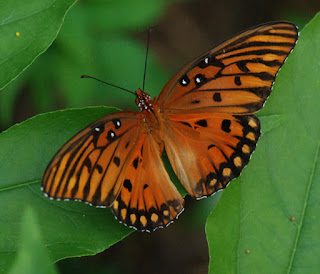The fragrances of the earth enjoin and
blossom in my nostrils and
sinus -
breath is what we
share with the world.
- Gavin Geoffrey Dillard, Graybeard Abbey
Hmmmm. Seems like a good month to participate in Wildflower Wednesday, but what flower should I pick?
The spotted beebalm (Monarda punctata) that just started blooming?
The turkey tangle fogfruit (Phyla nodiflora) that I concurrently both love and simply dislike?
The Devil's grandmother (Elephantopus tomentosus) that also just started to bloom and which is actually looking like a garden plant this summer since I finally got around to transplanting some into a bed this spring?
The "Eveready bunny" of my garden, the old sturdy standby Indian blanket (Gaillardia pulchella) that just keeps going and going and going and going?
The swamp milkweed (Asclepias incarnata) that I'm relying on to attract some monarchs to my gardens one of these days?
The trailing pineland lantana (Lantana depressa) out by the front sidewalk, with its lemonade colored blossoms covering tidy mounds of vibrantly bright green leaves?
Nope. Those are all cool and wonderful plants in my gardens, ...
...but I think I'm going for the maypop this time, a.k.a. passion vine (Passiflora incarnata). Every time I walk down on the deck or dock this summer, the rich fragrance of these impossibly glamorous blossoms startles my senses with its complex allure. Is it possible that the aroma of these blooms has given rise to the name "passion vine"? I know that's not the commonly told history, which involves some rather convoluted symbolism about the "passion of Christ", but passion vine fragrance is every bit as romantic as gardenia to me. This has been the first year that I've really processed how deeply fragrant these flowers are. To my nose, I think the smell of maypop flowers is richer even than that of roses - and I love the fragrance of roses.
I wish there was a way to put a scratch & sniff app into this blog post.....
I'm obviously not the only living creature that thinks maypop flowers smell appealing, as I frequently see pollinators on them. These big blooms seem built for BIG pollinators. Recently, for example, I've seen both...
carpenter bees (Xylocopa virginica)...
and this huge scarab hunter wasp (Campsomeris quadrimaculata) acting almost drunk with the richness of the nectar they are drinking. Note that the back and head of this wasp are actually coal black without pollen on them. Yes, this wasp has accidentally gathered THAT MUCH pollen!
As this photo with the blurry carpenter bee shows, there is a horizontal space between the stigmas (curved, long and white with greenish tips) and anthers (yellowish rectangles) and the nectary (reddish purple fuzzy area at the base of the central stalk) that seems expressly designed for such big floral visitors. If you look back at the photos above, you can see how absolutely covered with pollen the backs of these large insects are! A smaller bee or wasp wouldn't be anywhere close to as efficient in transferring pollen as these big guys are.
A consequence of such efficient pollination is, of course, the production of seeds. In the case of passion vine, the seeds are housed in the passion fruit. For years I've heard that these tennis ball sized fruits are edible, but I've never tried one before because, quite frankly, they just didn't look that appealing to me. I've decided that this year I'm going to be a bit more adventurous. According to the web, the fruits are ripe when they start to turn yellow, get wrinkled, and fall off the vine, so I'm keeping my eyes open. If these fruits taste at all like their fans online say, the taste may rival the fragrance of the flowers.
Humans, bees, and wasps aren't the only animals that love passion vines. As almost anyone who has planted one knows, gulf fritillaries (Agraulis vanillae) use them as their larval plants and the fritillary caterpillars can quickly reduce a vine to tatters. In fact, during most growing seasons I have to remind myself to "tolerate the uglies" so that my vine(s) can send many more gorgeously glowing, orange, floating "flowers" off into the breezes. Luckily, no matter how thoroughly the passion vines are eaten, they always seem to survive and thrive the following year.
This year, however, has been different. I saw 4 gulf fritillary caterpillars about 2 months ago, but I haven't seen another one since then...until yesterday. Meanwhile my vines have grown huge, luxurious, almost rampant. As passionvines do, new vines are sprouting up a dozen feet or more from the parent plant in every direction and they are now even starting to impinge on the deck stairs. There are plenty of blossoms and a burgeoning crop of that intriguing fruit is developing. A myriad of flower buds promise ever increasing numbers of blooms still to come. Truth to tell, it's all beginning to get a little over-the-top, but I don't want to cut it back. I'm waiting for the caterpillars to come and do that for me.
Finally, yesterday, I found 2 little gulf fritillary cats determinedly munching away. Then, this afternoon, another 3 more. Hopefully at least a couple of these tiny orange babies will make it to adulthood, providing some much needed pruning along the way. Meanwhile, I'm joyously sharing the breath of the world with every deep inhalation of that glorious passion vine fragrance.















2 comments:
Clever post and delightful introduction to the star!
So refreshing to see someone deliberately planting for and welcoming caterpillars.
Sometimes it feels like an uphill battle to get gardeners to live with caterpillars EATing their LEAVES!!
Post a Comment